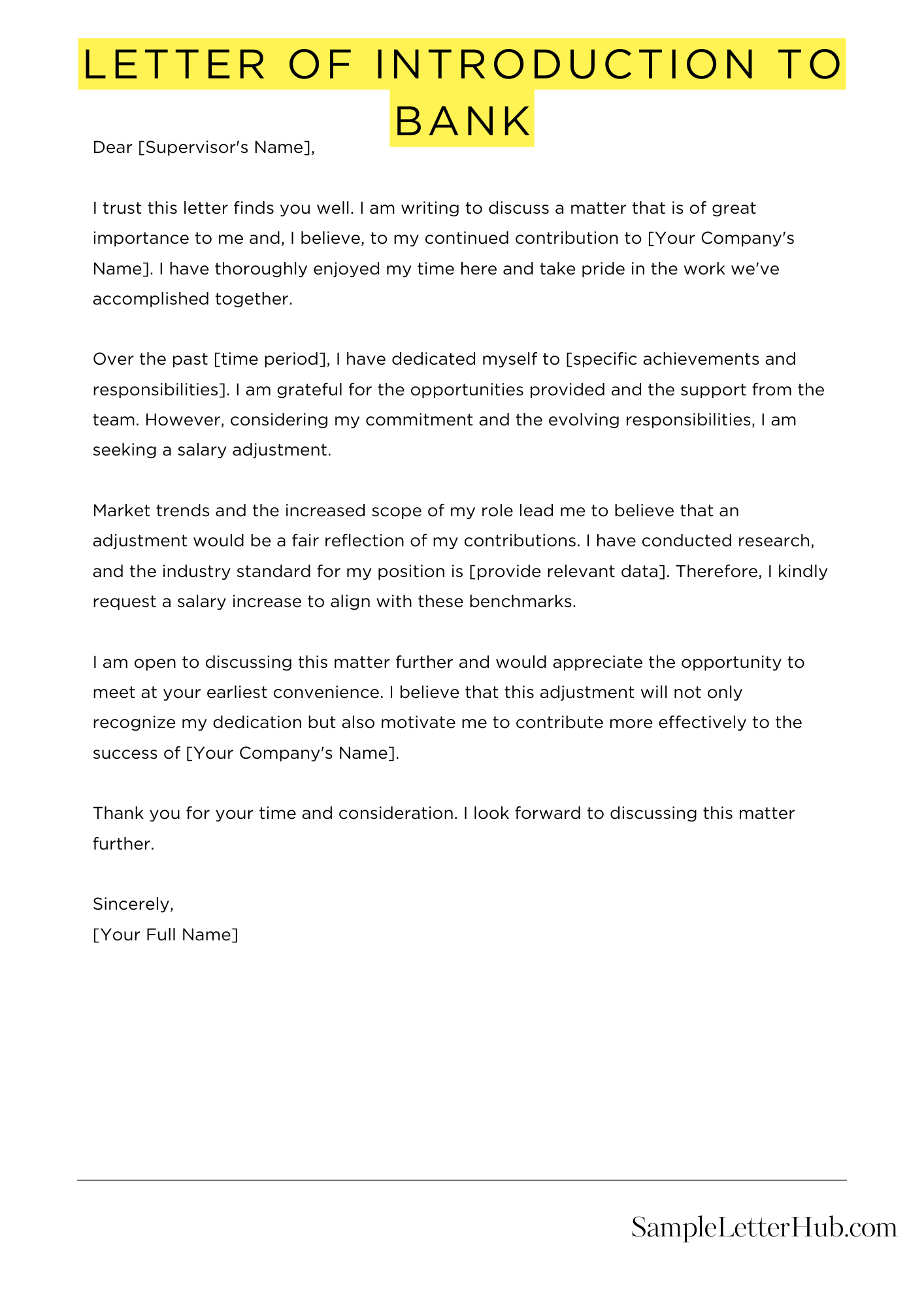A Letter of Introduction to Bank is a formal letter that introduces an individual or a company to a bank. It is typically used when opening a new bank account, seeking a loan, or establishing a business relationship with the bank. The purpose of this letter is to provide the bank with basic information about the individual or company, including their identity, background, and financial standing.
In this article, we will share several templates, examples, and samples of Letters of Introduction to Bank. These templates and samples are designed to help you easily create your own letter, regardless of your specific needs. Whether you are an individual looking to open a personal bank account or a business owner seeking a loan, you will find a template or sample that meets your requirements.
By using one of our templates or samples, you can save time and ensure that your Letter of Introduction to Bank is well-written and professional. Simply choose the template or sample that best fits your needs, fill in the blanks with your own information, and submit it to the bank.
Letter of Introduction to Bank
Dear [Bank Manager’s Name],
I am writing to introduce myself and request the opportunity to establish a banking relationship with your institution. My name is [Your Name], and I am a [Your Profession/Occupation].
I have been a resident of [Your City] for [Number] years and have a strong financial history. I am currently employed by [Your Employer] and have a stable income. I am seeking a financial institution that can provide me with a range of banking services to meet my needs.
I am particularly interested in your bank’s [Specific Services or Products]. I believe that your offerings would be a valuable asset to my financial management. I am also impressed by your bank’s reputation for [Bank’s Reputation or Accomplishments].
I am confident that I would be a valuable customer to your bank. I am a responsible individual with a proven track record of financial stability. I am also eager to explore the various products and services that your bank has to offer.
I would appreciate the opportunity to schedule a meeting with you to discuss my banking needs further. Please contact me at your convenience to arrange a time.
Thank you for your time and consideration.
Sincerely,
[Your Signature]

How to Write a Letter of Introduction to a Bank
A letter of introduction to a bank is a formal document that introduces you to a bank and requests that they open an account for you. It is typically used when you are opening a new account or when you are moving your account to a new bank.
What to Include in a Letter of Introduction to a Bank
Your letter of introduction should include the following information:
- Your full name
- Your address
- Your phone number
- Your email address
- The date
- The name of the bank
- The address of the bank
- A brief introduction of yourself
- A statement of your purpose for writing the letter
- A request that the bank open an account for you
- Your signature
How to Write a Letter of Introduction to a Bank
When writing a letter of introduction to a bank, it is important to be professional and concise. You should also use clear and concise language. Here is a sample letter of introduction to a bank:
Dear [Bank Name],
I am writing to introduce myself and to request that you open an account for me. My name is [Your Name] and I live at [Your Address]. I can be reached by phone at [Your Phone Number] or by email at [Your Email Address].
I am a [Your Occupation] and I have been working in the [Your Industry] industry for [Number] years. I am currently employed by [Your Employer].
I am opening an account with your bank because I am impressed with your reputation for customer service and your competitive rates. I am also looking for a bank that can provide me with the financial services that I need, such as online banking, mobile banking, and bill pay.
I am confident that I will be a valuable customer to your bank. I am a responsible and reliable individual with a good credit history. I am also committed to managing my finances responsibly.
Thank you for your time and consideration. I look forward to hearing from you soon.
Sincerely,
[Your Signature]
Tips for Writing a Letter of Introduction to a Bank
Here are a few tips for writing a letter of introduction to a bank:
- Be professional and concise.
- Use clear and concise language.
- Proofread your letter carefully before sending it.
- Include all of the necessary information.
- Be confident and assertive.
FAQs about Letter Of Introduction To Bank
What is a Letter of Introduction to Bank?
A Letter of Introduction to Bank (LOI) is a formal document issued by a company or organization to introduce an individual to a bank. It serves as a recommendation and provides the bank with information about the individual’s purpose for opening an account or seeking financial services.
What are the key elements of a Letter of Introduction to Bank?
A well-written LOI typically includes the following elements:
- Company or organization letterhead
- Date
- Recipient’s name and title
- Name and contact information of the individual being introduced
- Purpose of the introduction
- Statement of recommendation
- Signature of the authorized representative
When is a Letter of Introduction to Bank required?
An LOI is typically required when an individual is opening a new bank account, especially for business purposes, or seeking specific financial services that require a higher level of due diligence.
Who can issue a Letter of Introduction to Bank?
An LOI can be issued by a company or organization that has a business relationship with the individual being introduced. This could include employers, accountants, lawyers, or other trusted entities.
What are the benefits of having a Letter of Introduction to Bank?
An LOI can provide several benefits, including:
- Enhanced credibility and trust with the bank
- Smoother and faster account opening process
- Access to a wider range of financial services
- Improved chances of loan approvals

